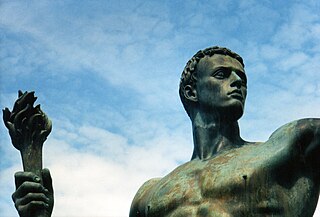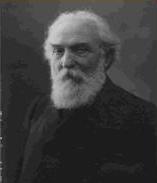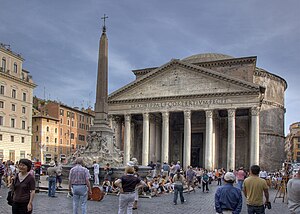
Fascism is a far-right, authoritarian, and ultranationalist political ideology and movement, characterized by a dictatorial leader, centralized autocracy, militarism, forcible suppression of opposition, belief in a natural social hierarchy, subordination of individual interests for the perceived good of the nation or race, and strong regimentation of society and the economy. Opposed to anarchism, democracy, pluralism, egalitarianism, liberalism, socialism, and Marxism, fascism is at the far right of the traditional left–right spectrum.
The Aryan race is a pseudoscientific historical race concept that emerged in the late-19th century to describe people who descend from the Proto-Indo-Europeans as a racial grouping. The terminology derives from the historical usage of Aryan, used by modern Indo-Iranians as an epithet of "noble". Anthropological, historical, and archaeological evidence does not support the validity of this concept.

The master race is a pseudoscientific concept in Nazi ideology, in which the putative "Aryan race" is deemed the pinnacle of human racial hierarchy. Members were referred to as "Herrenmenschen".

Giulio Cesare Andrea "Julius" Evola was an Italian far-right philosopher. Evola regarded his values as traditionalist, aristocratic, martial, and imperialist. An eccentric thinker in Fascist Italy, he also had ties to Nazi Germany; in the post-war era, he was an ideological mentor of the Italian neo-fascist and militant Right.

Aryanism, is an ideology of German racial supremacy which views the supposed Aryan race as a distinct and superior racial group which is entitled to rule the rest of humanity. Initially promoted by racial theorists such as Arthur de Gobineau and Houston Stewart Chamberlain, Aryanism reached its peak of influence in Nazi Germany. In the 1930s and 40s, the regime applied the ideology with full force, sparking World War II with the 1939 invasion of Poland in pursuit of Lebensraum, or living space, for the Aryan people. The racial policies which were implemented by the Nazis during the 1930s came to a head during their conquest of Europe and the Soviet Union, culminating in the industrial mass murder of six million Jews and eleven million other victims in what is now known as the Holocaust.
The Mediterranean race is an obsolete racial classification of humans based on the now-disproven theory of biological race. According to writers of the late 19th to mid-20th centuries it was a sub-race of the Caucasian race. According to various definitions, it was said to be prevalent in the Mediterranean Basin and areas near the Mediterranean and Black Sea, especially in Southern Europe, Eastern Europe, North Africa, most of West Asia, the Middle East or Near East; western Central Asia, parts of South Asia, and parts of the Horn of Africa. To a lesser extent, certain populations of people in Ireland, western parts of Great Britain, and Southern Germany, despite living far from the Mediterranean, were thought to have some minority Mediterranean elements in their population, such as Bavaria, Wales, and Cornwall.
Nordicism is an ideology which views the "Nordic race" as an endangered and superior racial group. Some notable and influential Nordicist works include Madison Grant's book The Passing of the Great Race (1916); Arthur de Gobineau's An Essay on the Inequality of the Human Races (1853); the various writings of Lothrop Stoddard; Houston Stewart Chamberlain's The Foundations of the Nineteenth Century (1899); and, to a lesser extent, William Z. Ripley’s The Races of Europe (1899). The ideology became popular in the late-19th and 20th centuries in Germanic-speaking Europe, Northwestern Europe, Central Europe, and Northern Europe, as well as in North America and Australia.

Giuseppe Sergi was an Italian anthropologist of the early twentieth century, best known for his opposition to Nordicism in his books on the racial identity of Mediterranean peoples. He rejected existing racial typologies that identified Mediterranean peoples as "dark whites" because they implied a Nordicist conception of Mediterranean peoples descending from whites who had become racially mixed with non-whites which he claimed was false. His concept of the Mediterranean race, identified Mediterranean peoples as being an autonomous brunet race and he claimed that the Nordic race was descended from the Mediterranean race whose skin had depigmented to a pale complexion after it moved north. This concept became important to the modelling of racial difference in the early twentieth century.

Giacomo Acerbo, Baron of Aterno, was an Italian economist and politician. He is best known for having drafted the Acerbo Law that allowed the National Fascist Party (PNF) to achieve a supermajority of two-thirds of the Italian Parliament after the 1924 Italian general election, which saw intimidation tactics against voters.

The history of fascist ideology is long and it draws on many sources. Fascists took inspiration from sources as ancient as the Spartans for their focus on racial purity and their emphasis on rule by an élite minority. Researchers have also seen links between fascism and the ideals of Plato, though there are key differences between the two. Italian Fascism styled itself as the ideological successor to Ancient Rome, particularly the Roman Empire. Georg Wilhelm Friedrich Hegel's view on the absolute authority of the state also strongly influenced fascist thinking. The 1789 French Revolution was a major influence insofar as the Nazis saw themselves as fighting back against many of the ideas which it brought to prominence, especially liberalism, liberal democracy and racial equality, whereas on the other hand, fascism drew heavily on the revolutionary ideal of nationalism. The prejudice of a "high and noble" Aryan culture as opposed to a "parasitic" Semitic culture was core to Nazi racial views, while other early forms of fascism concerned themselves with non-racialized conceptions of their respective nations.

The "Manifesto of Race", otherwise referred to as the Charter of Race or the Racial Manifesto, was an Italian manifesto promulgated by the government of Benito Mussolini on 14 July 1938. Its promulgation was followed by the enactment, in October 1938, of the Racial Laws in Fascist Italy and the Italian Empire.

The German Nazi Party adopted and developed several racial hierarchical categorizations as an important part of its fascist ideology (Nazism) in order to justify enslavement, extermination, ethnic persecution and other atrocities against ethnicities which it deemed genetically or culturally inferior. The Aryan race is a pseudoscientific concept that emerged in the late-19th century to describe people who descend from the Proto-Indo-Europeans as a racial grouping and it was accepted by Nazi thinkers. The Nazis considered the putative "Aryan race" a superior "master race" with Germanic peoples as representative of Nordic race being best branch, and they considered Jews, mixed-race people, Slavs, Romani, Black People, and certain other ethnicities racially inferior subhumans, whose members were only suitable for slave labor and extermination. In these ethnicities, Jews were considered the most inferior. However, the Nazis considered Germanic peoples such as Germans to be significantly mixed between different races, including the East Baltic race being considered inferior by the Nazis, and that their citizens needed to be completely Nordicized after the war. The Nazis also considered some non-Germanic groups such as Sorbs, Northern Italians, and Greeks to be of Germanic and Nordic origin. Some non-Aryan ethnic groups such as the Japanese were considered to be partly superior, while some Indo-Europeans such as Slavs, Romani, and Indo-Aryan people people were considered inferior.

Nazi archaeology was a field of pseudoarcheology led and encouraged by various Nazi leaders and Ahnenerbe figures, such as Adolf Hitler and Heinrich Himmler, which directed archaeologists and other scholars to search Germany's archeological past in order to find material evidence supporting an advanced, Aryan ancestry as alleged and espoused by the ultranationalist Nazi Party.

Fascist movements in Europe were the set of various fascist ideologies which were practiced by governments and political organizations in Europe during the 20th century. Fascism was born in Italy following World War I, and other fascist movements, influenced by Italian Fascism, subsequently emerged across Europe. Among the political doctrines which are identified as ideological origins of fascism in Europe are the combining of a traditional national unity and revolutionary anti-democratic rhetoric which was espoused by the integral nationalist Charles Maurras and the revolutionary syndicalist Georges Sorel.

The Italian racial laws, domestically referred to as the Racial Laws, were a series of laws promulgated by the government of Benito Mussolini in Fascist Italy from 1938 to 1944 in order to enforce racial discrimination and segregation in the Kingdom of Italy. The main victims of the Racial Laws were Italian Jews and the African inhabitants of the Italian Empire.

Racism in Italy refers to the existence of antagonistic relationships between Italians and other populations of different ethnicities which has existed throughout the country's history.

The Greater Germanic Reich, fully styled the Greater Germanic Reich of the German Nation, was the official state name of the political entity that Nazi Germany tried to establish in Europe during World War II. The territorial claims for the Greater Germanic Reich fluctuated over time. As early as the autumn of 1933, Adolf Hitler envisioned annexing such territories as Bohemia, western Poland, and Austria to Germany and the formation of satellite or puppet states without independent economies or policies of their own.

Initially, Fascist Italy did not enact comprehensive racist policies like those policies which were enacted by its World War II Axis partner Nazi Germany. Italy's National Fascist Party leader, Benito Mussolini, expressed different views on the subject of race over the course of his career. In an interview conducted in 1932 at the Palazzo di Venezia in Rome, he said "Race? It is a feeling, not a reality: ninety-five percent, at least, is a feeling. Nothing will ever make me believe that biologically pure races can be shown to exist today".

Fascist Italy is a term which is used in historiography to describe the Kingdom of Italy when it was governed by the National Fascist Party from 1922 to 1943 with Benito Mussolini as prime minister and dictator. The Italian Fascists imposed totalitarian rule and crushed political opposition, while simultaneously promoting economic modernization, traditional social values and a rapprochement with the Roman Catholic Church.
The Nordic Indo-Germanic people is a mythological group, from which the Germanic peoples allegedly descended. The assumption of the existence of this primordial people was developed by nationalists in the German territories from the early 19th century onwards, and was the subject of intense research in both the 19th and 20th centuries. Nineteenth-century German philologists, ethnologists and historians initially focused their research on the Eastern origins of Germanic populations. Then, in a second phase, these researchers changed the focus of their work to demonstrate the Nordic origin of Germanic populations and civilization. These results were soon deliberately exploited in the debate on German identity that raged throughout the nineteenth century.














